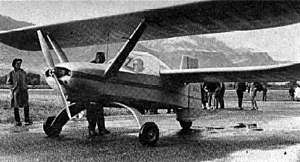Croses Criquet
| EC-6 Criquet | |
|---|---|
 | |
| Croses EC-6 Criquet (F-WNGA) | |
| Role | recreational aircraft |
| Manufacturer | homebuilt |
| Designer | Emilien Croses |
| First flight | 6 July 1965 |
The Croses EC-6 Criquet ("Locust") is a 1960s French two-seat homebuilt aircraft designed by Emilien Croses.
Development
The EC-6 Criquet is a design for a homebuilt aircraft with a tailwheel landing gear, and tandem wing configuration similar to the Mignet Pou-du-Ciel family. It has two side-by-side seats. It first flew in 1965, and seven examples had flown by 1977, with more than 60 known to be under construction.
The EC-6 Criquet Léger (Mini Criquet) is an ultralight variant.[1]
The LC-6 Criquet is an improved version developed by Gilbert Landray.[1]
The LC-10 Criquet was developed by a Mr Millet of Société Co-Plasud who used fibreglass construction throughout the entire aircraft. It was used as a trainer by the Aéro-Club du Maconnais. While considerably more expensive to build than a conventional wooden Criquet, the fibreglass version was also 80 kg (180 lb) heavier.[2]
Variants
- EC-6 Criquet
- (English:cricket) The original version designed by Emilien Croses.[3]
- EC-6 Criquet Léger
- An ultralight version.
- LC-6 Criquet
- (LC - Landray-Coses) The EC-6 modified and improved by Gilbert Landray.[3]
- LC-10 Criquet
- (LC - Laibie-Coses) An all fibre-glass version of the EC-6 built by M. Millet of Société Co-Plasud (president of the Aero-club de l'Aude). A second LC-10 was built by M. Barrière.[2]
Specifications (EC-6 no.01 Criquet)
Data from Jane's all the world's aircraft, 1975-76,[4] Simpson (2001)[1]
General characteristics
- Crew: 2
- Length: 4.65 m (15 ft 3 in)
- Forward wing span: 7.8 m (26 ft)
- Rear wing span: 7 m (23 ft)
- Wing area: 16 m2 (170 sq ft)
- Aspect ratio: 6.5 (forward wing) ; 5.833 (rear wing)
- Airfoil: NACA 23012 modified
- Empty weight: 200 kg (441 lb)
- Max takeoff weight: 550 kg (1,213 lb)
- Fuel capacity: 60 l (16 US gal; 13 imp gal)
- Powerplant: 1 × Continental C90 4-cyl. air-cooled horizontally-opposed piston engine, 67 kW (90 hp)
- Propellers: 2-bladed SIPA propeller
Performance
- Maximum speed: 213 km/h (132 mph; 115 kn)
- Cruise speed: 160 km/h (99 mph; 86 kn)
- Minimum flying speed: (will not stall) 40 km/h (25 mph; 22 kn)
- Range: 480 km (298 mi; 259 nmi)
- Time to altitude: 6 minutes 14 seconds to 2,000 m (6,600 ft)
See also
References
- 1 2 3 Simpson, Rod (2001). Airlife's world aircraft : the complete reference to civil, military and light aircraft. Shrewsbury: Airlife. ISBN 1-84037-115-3.
- 1 2 Gaillard, Pierre (1991). Les Avions Francais de 1965 a 1990 (in French). Paris: Editions EPA. p. 135. ISBN 2 85120 392 4.
- 1 2 Gaillard, Pierre (1991). Les Avions Francais de 1965 a 1990 (in French). Paris: Editions EPA. p. 43. ISBN 2 85120 392 4.
- ↑ Taylor, John W.R., ed. (1975). Jane's all the world's aircraft, 1975-76 (66th annual ed.). New York: Franklin Watts Inc. p. 56. ISBN 978-0531032503.
Further reading
- Taylor, John W.R.; Munson, Kenneth, eds. (1977). Jane's all the World's Aircraft 1977-78 (Sixty-eighth year of issue. ed.). London: Jane's Yearbooks. pp. 486–487. ISBN 9780531032787.
- Taylor, Michael J.H. (1989). Jane's Encyclopaedia of Aviation. London: Studio Editions. p. 272. ISBN 978-0-517-69186-1.
| Wikimedia Commons has media related to Croses Criquet. |